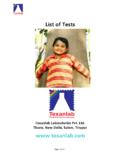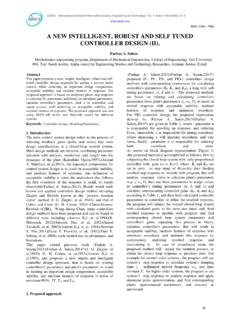Transcription of Colour fastness to Ozone - Texanlab
1 Texanlab Laboratories Pvt. Ltd. Colourfastness Testing Series Colour fastness to Ozone 1 This test is intended for determining the resistance of Colour on textile material to the action of Ozone contamination present in atmosphere. This test is primarily applied on the textile materials which has been dyed with indigo dyes and bleached materials which are treated with optical brightener. Such materials prone to turn yellow after prolonged exposure in the atmosphere which is contaminated with Ozone . Even the radiations emitted by light source used in stores for the display of garments contain fairly good amount of Ozone and because of which bleached or indigo dyed garments tend to turn yellow after prolonged exposure.
2 Ozone contamination in the atmosphere is also greatly influenced by temperature and moisture content. This is very reason that this test is performed in two different atmospheric conditions namely low humidity / temperature and high humidity / temperature. This test is primarily performed for US retailers. Very few European customers opt for this test. Most tests are performed at low humidity. PrinciplePrinciplePrinciplePrinciple The sample under test along with control fabric is exposed in a chamber generating Ozone at a specified concentration (ppm) of Ozone level with specified atmospheric conditions so as to obtain definite Colour change.
3 This will constitute one cycle. The sample is exposed to one or two cycles as the case may be and compared with original specimen for Colour change (yellowness). Generally denim samples are exposed for two cycles and white is exposed for one. STANDARD TEST METHODSTANDARD TEST METHODSTANDARD TEST METHODSTANDARD TEST METHODS APPLIEDS APPLIEDS APPLIEDS APPLIED AATCC 109:2005 - Colour fastness to Ozone in the atmosphere under Low humidity AATCC 129:2005 - Colour fastness to Ozone in the atmosphere under High humidity ISO 105 G03 : Colour fastness to Ozone in the atmosphere AATCC 109 : 2005 AATCC 109 : 2005 AATCC 109 : 2005 AATCC 109 : 2005 AATCC 129: 2005 AATCC 129: 2005 AATCC 129: 2005 AATCC 129: 2005 ISO 105 G03:1993 ISO 105 G03:1993 ISO 105 G03:1993 ISO 105 G03.
4 1993 Typical Typical Typical Typical ApparatusApparatusApparatusApparatus / / / / Equipment neededEquipment neededEquipment neededEquipment needed Ozone generating chamber which can control emission of Ozone in ppm Test specimen size 10 cm X 6 cm Original / Washed / Dry cleaned 10 cm X 6 cm Original / Washed / Dry cleaned 10 cm X 6 cm Test conditionsTest conditionsTest conditionsTest conditions Temperature Relative Humidity (RH) 210 C + 10 C / 65 + 2 % (should not exceed 67%) 400 C + 10 C / + % Both conditions not exceeding 65% (18 280 C) and above 80% (400 + 50 C RH 85 + 5%) Colour fastness TO Ozone Texanlab Laboratories Pvt. Ltd. Colourfastness Testing Series Colour fastness to Ozone 2 AATCC 109 : 2005 AATCC 109 : 2005 AATCC 109 : 2005 AATCC 109 : 2005 AATCC 129: 2005 AATCC 129: 2005 AATCC 129: 2005 AATCC 129: 2005 ISO 105 G03:1993 ISO 105 G03:1993 ISO 105 G03:1993 ISO 105 G03:1993 No of cycles exposure 1.
5 Specimen shows a definite Colour change 2. Prescribed number of cycles 1. Specimen shows a definite Colour change 2. Prescribed number of cycles 1. Specimen shows a definite Colour change 2. Prescribed number of cycles Conditions required for Conditions required for Conditions required for Conditions required for OneOneOneOne cycle cycle cycle cycle Ozone level / Time Approximate ppm level to get std. fading. h Ozone concentration range from 10-35 pphm (Parts Per Hundred Million) which should produce one cycle of fading in 3-28 h of test. h for Low Low Low Low humidityhumidityhumidityhumidity Approximate ppm level to get std. fading. Ozone concentration range from 10-35 pphm which should produce one cycle of fading in 3-28 h of test.
6 For High humidityHigh humidityHigh humidityHigh humidity Reporting Numerical grade for Colour change with the help of grey scale immediately after the test Numerical grade for Colour change with the help of grey scale immediately after the test Numerical grade for Colour change with the help of grey scale immediately after the test Typical equipment:Typical equipment:Typical equipment:Typical equipment: Technical explanation:Technical explanation:Technical explanation:Technical explanation: Ozone -induced yellowing is a major problem in denims. The Ozone layer, found in the upper atmosphere of earth, absorbs the sun's UV radiation. Due to the increased pollution levels from industry as well as vehicles, the concentration of NOX and SOx gases have increased in the atmosphere.
7 These gases can potentially react with Ozone and reduce its concentration tremendously in the Ozone layer. As a result, a portion of the sun's UV radiation penetrates through the atmospheric layer and reaches the earth's surface. This UV light can generate Ozone gas from the atmospheric oxygen. The deteriorating effect O3 has on denim is irreversible. Based on molecular weight calculation, 1 g of Ozone could destroy g of indigo dye. Since the O3 induced oxidation of indigo produces a compound (isatin), which is yellow in Colour , denim garments turn yellow due to Ozone fading. Texanlab Laboratories Pvt. Ltd. Colourfastness Testing Series Colour fastness to Ozone 3 Causes:Causes:Causes:Causes: It is essential to control pH in the processes of indigo dyeing / enzyme treatments on denims and optical brighterner treatment on bleached material.
8 It is advisable to neutralise / hot rince the material after treatments as any residual chemicals present on the fabric can contribute greatly towards yellowing and hence poor Colour fastness to Ozone . Case studyCase studyCase studyCase study 1 1 1 1 A denim garment was observed to turn yellow excessively at fold portions which was exposed to store light directly. The same sample when tested in the laboratory for Colour fastness to Ozone also revealed that fabric was having poor Colour fastness . One of the main cause for this can be back staining occured in denim during enzyme treatment and no subsequent neutralising / hot rinsing could have been done.
9 The residual Colour present in the garment after enzyme treatment will tend to yellow after exposure. OriginalOriginalOriginalOriginal TestedTestedTestedTested Texanlab Laboratories Pvt. Ltd. Colourfastness Testing Series Colour fastness to Ozone 4 Representative picture of denim garment. Case study 2 Case study 2 Case study 2 Case study 2 A white garment which was treated with optical brightener agent was observed to turn yellow when displayed in store at portions. This can take place if pH is not controlled during OBA treatment and no subsequent rinsing is done. CaCaCaCaution:ution:ution:ution: It is advisable to wear safety glasses in laboratory as Ozone is sensory irritant and test chamber should be ventilated to the outside atmosphere.
10







